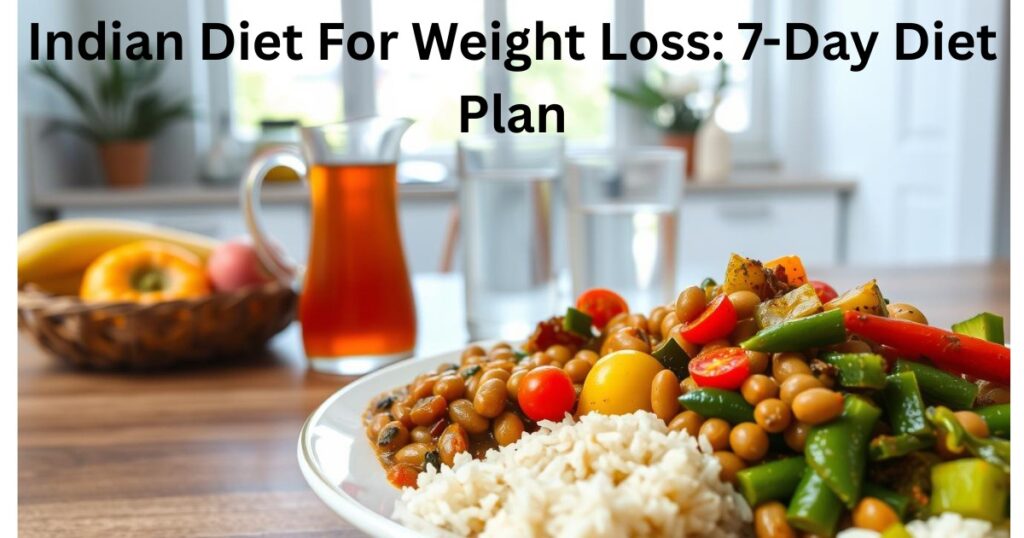Starting a weight loss journey can seem daunting. But, the key might be in the rich, vibrant world of Indian cuisine. It’s not about cutting out food; it’s about feeding your body with healthy, tasty ingredients that help you reach your goals.
Indian cooking is full of nutritious options that can change how you manage your weight. You’ll learn about protein-rich lentils and spices that boost your metabolism. This 7-day plan shows how to use Indian food to lose weight while enjoying tasty meals.
This guide explains the science behind losing weight with an Indian diet. It offers practical tips that go beyond usual diet plans. You’ll see how traditional ingredients, portion control, and smart cooking can lead to lasting weight loss without losing flavor or cultural touch.
If you want to lose weight, get healthier, or just learn about Indian cuisine’s nutritional benefits, this plan is for you. It’s a holistic approach that honors your body and your culinary roots. Prepare to embark on a weight loss journey that’s more like a tasty adventure than a challenge.
Understanding Indian Weight Loss Diet Fundamentals
The Indian diet for weight loss is more than just counting calories. It’s a complete approach to nutrition. Traditional Indian food is full of ingredients and cooking methods that help manage weight well.

Nutritionists say it’s key to know about Indian diet habits. It’s all about balancing food, controlling portions, and planning meals wisely.
Benefits of Traditional Indian Ingredients
Indian cooking is full of ingredients that help with weight loss:
- Turmeric: A spice that fights inflammation
- Lentils: These legumes are high in protein and low in calories
- Whole grains: They give you energy for a long time
- Yogurt: It’s good for your gut and helps with metabolism
Role of Portion Control in Weight Management
Controlling portions is very important in the Indian diet for weight loss. Traditional eating habits naturally lead to eating less. Here are some tips:
- Use smaller plates
- Eat mindfully
- Balance your macronutrients
- Don’t take seconds
Importance of Meal Timing
Nutritionists say meal timing is very important. In Indian culture, eating at the same times helps your metabolism. This supports weight loss goals.
Eating your biggest meal at midday and having a light dinner can help with weight management.
By understanding these basics, you can change how you view nutrition. You can lose weight in a healthy way using the rich Indian culinary tradition.
Indian Diet For Weight Loss: Core Principles

To make an Indian Diet For Weight Loss work, you need to know some key nutrition rules. These rules make traditional Indian eating great for losing weight. They focus on balanced nutrition, smart food mixing, and eating with care.
Nutrition experts give these important tips for diet plans:
- Protein-Rich Combinations: Pairing foods strategically maximizes nutritional value
- Diverse Vegetable Intake: Ensuring wide nutrient spectrum
- Low-Glycemic Food Selection: Stabilizing blood sugar levels
- Portion Control: Managing calorie consumption
In Indian cooking, mixing foods is an art. For example, mixing rice with lentils makes a complete protein. This way, you get all the amino acids you need. It makes meals full and packed with nutrients.
The Indian Diet For Weight Loss focuses on real, unprocessed foods. It’s based on lean proteins, fiber-rich veggies, and complex carbs. Cooking methods like steaming, grilling, and using little oil help keep your metabolism healthy.
Intelligent nutrition isn’t about restriction—it’s about making informed, balanced choices.
Learning these core principles changes how you eat. It turns simple meals into smart nutrition choices.
Male-Specific Diet Requirements
Creating a good male Indian diet chart means knowing what men need. Men usually need more calories and protein than women. This makes their weight loss path different.

A well-made male Indian diet chart aims for balanced nutrition. It helps keep muscles and lose fat. Men have special dietary needs that need careful planning and smart food choices.
Plant-Based Diet Options
Plant-based diets are great for men’s weight loss. They include:
- Lentils and legumes for protein
- Whole grains like quinoa and brown rice
- Nuts and seeds for healthy fats
- Green leafy vegetables
Protein Requirements for Men
Protein is key for keeping muscles during weight loss. Men should aim for:
- 1.6-2.2 grams of protein per kilogram of body weight
- Lean protein sources like chicken, fish, and eggs
- Plant-based proteins such as tofu and chickpeas
“Nutrition is the foundation of fitness and weight management for men.” – Indian Nutrition Expert
Recommended Portion Sizes
Controlling portions is important in a male Indian diet chart. Men should focus on:
- Balanced meal sizes
- Controlled carbohydrate intake
- Adequate protein portions
- Mindful eating practices
Knowing these nutrition basics helps men make a weight loss plan that fits their needs.
Female-Specific Diet Guidelines
Creating a good female Indian diet chart means knowing what women need. It’s not just about counting calories. It’s about keeping health, hormones, and weight in check.
Women need different things from their diet than men do. A female Indian diet chart should focus on nutrients that help with:
- Hormonal health
- Bone density
- Iron levels
- Reproductive wellness
For a diet to work, it should include foods full of good stuff. Calcium-rich foods like dairy, leafy greens, and fortified options are key for strong bones. Foods high in iron, like lentils and spinach, are important too.
A balanced diet that blends traditional Indian foods with modern knowledge is key for women to lose weight.
Mindful eating is important in a female Indian diet. This means:
- Choosing whole foods
- Managing portion sizes
- Understanding individual nutritional needs
- Listening to bodily signals
Hormonal shifts and metabolism changes need a flexible diet. Women should eat nutrient-rich, low-processed foods. These help keep energy up all day.
Day One: The Energizing Start
Starting your weight loss journey needs a smart plan. Day 1 is all about getting energized and setting the stage for a week of healthy eating. This day is key to boosting your metabolism and helping you manage your weight.
The first day focuses on a balanced diet that keeps you energized and gives you the nutrients you need. Good meal planning is essential to start strong.
Morning Ritual and Breakfast Options
Begin your day with a wellness routine:
- Drink warm water with lemon to kickstart metabolism
- Practice 10 minutes of light stretching or yoga
- Prepare a nutrient-dense breakfast
For breakfast, try soaked blended oatmeal with fresh apples and bananas. It’s packed with complex carbs, fiber, and vitamins to kick off your day right.
Lunch and Dinner Combinations
Choosing balanced meals is key to keeping your energy up:
- Lunch: Whole wheat chapati with mixed vegetable curry
- Dinner: Brown rice with protein-rich lentil dal
Healthy Snacking Choices
Snacking wisely helps avoid overeating and keeps your energy steady. A chickpea salad with fresh veggies is a great choice for a mid-afternoon snack.
Remember, day 1: the energizing start is about creating sustainable habits that support your weight loss goals.
Day Two and Three: Building Momentum
Starting your weight loss journey needs smart meal planning and steady nutrition. Day 2 is all about getting the nutrients your body needs. It helps you manage your weight.
Day 2’s meal plan is all about the right mix of protein and carbs. Begin with a moong dal chila and a glass of milk for breakfast. This combo gives you energy and keeps you full.
- Breakfast: Moong dal chila with milk
- Lunch: Whole wheat chapati with soya bean curry
- Snack: Banana, mango, and yogurt smoothie
- Dinner: Quinoa and vegetable stir-fry
Day 3 is all about eating a variety of foods. Start with a daliya (broken wheat porridge) and fresh fruit. It’s a fiber-packed way to begin your day.
- Breakfast: Daliya with seasonal fruit
- Lunch: Vegetable fried rice with curd
- Snack: Vegetable bhel puri with citrus fruit
- Dinner: Stir-fried tofu with mixed vegetables
Every meal is made to give you the nutrients you need while keeping calories low. It’s not just about eating less. It’s about eating the right foods.
Remember, consistency is more important than perfection in your weight loss journey.
Day Four and Five: Maintaining Progress
Getting through the middle of your weight loss journey needs smart planning and careful eating. Day 4 is all about filling and wholesome meals to keep you full and on track. Day 5 focuses on refreshing your body with cleansing foods.
Mid-Week Meal Planning Strategies
For lasting weight loss, planning your meals is key. On day 4, try these satisfying meals:
- Breakfast: Vegetable poha with masala chai
- Lunch: Nutritious vegetable pulao
- Snack: Dry roasted makhana
- Dinner: Methi paratha with fresh curd
Nutritional Balance Tips
Day 5 is about choosing foods that refresh your body. Make sure to include:
- Protein-rich ingredients
- Complex carbohydrates
- Fiber-packed vegetables
- Minimal processed foods
“Nutrition is not about being perfect. It’s about eating food that makes you feel great.” – Unknown
Hydration Guidelines
Drinking enough water is vital for your weight loss journey. Aim for:
- 8-10 glasses of water daily
- Herbal teas
- Fresh coconut water
- Infused water with cucumber or mint
Remember, your mid-week meals are key to keeping up the pace. Stay committed, listen to your body, and enjoy the nutritious Indian dishes that help you reach your weight loss goals.
Day Six and Seven: Finishing Strong
As you near the end of your weight loss journey, day 6 is all about making smart choices. This is a key time for planning your meals and eating mindfully. It’s all about reaching your health goals.
On day 6, your meals are all about being healthy and filling:
- Breakfast: Protein-packed paneer paratha with refreshing curd
- Lunch: Wholesome brown rice with protein-rich moong dal
- Snack: Nourishing clear soup with grilled vegetable sandwiches
- Dinner: Flavorful vegetable biryani accompanied by cooling raita
Day 7 is the last day of your dietary change. It’s all about balanced nutrition and celebrating your progress:
- Breakfast: Nutrient-dense millet dosa with zesty green chutney
- Lunch: Hearty jawar roti paired with protein-rich sprouts sabzi
- Snack: Refreshing fresh fruit juice
- Dinner: Comforting rajma with wholesome brown rice
Success comes from controlling portions and staying motivated. Every meal is a chance to make healthy choices that help you lose weight.
Remember, sustainable weight loss is about consistent, mindful eating patterns.
By finishing this 7-day journey, you’ve done more than just follow a diet. You’ve learned important nutrition strategies that can change your health for the better.
Essential Indian Superfoods for Weight Loss
The Indian diet is full of superfoods that help with weight loss. Finding the right mix of ingredients makes your weight loss journey tasty and successful.
Traditional Indian ingredients are key to good nutrition and weight control. These superfoods give you important nutrients and boost your metabolism.
Spices That Boost Metabolism
Indian spices are packed with nutrients for weight loss. Some of the best include:
- Turmeric: A strong anti-inflammatory that helps burn fat
- Cumin: Improves digestion and burns calories faster
- Cinnamon: Keeps blood sugar levels in check
Protein-Rich Indian Options
Protein is vital for weight management. It keeps you full and helps build muscle. Here are some top protein sources:
- Lentils (dal)
- Chickpeas
- Paneer (cottage cheese)
- Lean chicken
Fiber-Rich Ingredients
Fiber is key for lasting weight loss. Indian food is rich in fiber, which is good for digestion and keeps you full:
- Whole wheat rotis
- Brown rice
- Green leafy vegetables
- Seasonal fruits
Adding these superfoods to your meals makes for a balanced diet. It supports your weight loss goals and nourishes your body.
Smart Cooking Methods and Substitutions
Changing how you cook can really help with weight loss. Traditional Indian cooking often uses a lot of calories. But, by using smart cooking methods, you can eat less and keep the taste.
Nutritionists suggest several ways to cook for weight loss:
- Steaming vegetables and proteins to keep nutrients
- Grilling lean meats with little oil
- Baking instead of deep-frying
- Using non-stick cookware to cut down oil
Choosing the right cooking oils is key in weight loss diet plans. Choose heart-healthy oils with lower smoke points like:
- Extra virgin olive oil
- Coconut oil
- Canola oil
- Peanut oil
“Cooking smart is not about eliminating flavor, but about making healthier choices that support your weight loss journey.” – Renowned Nutritionist
Swapping out ingredients can cut calories without losing flavor. Try using Greek yogurt instead of cream, whole wheat flour instead of refined flour. Also, use herbs and spices to add flavor without extra calories.
Conclusion
The Indian Diet for Weight Loss is more than a short-term plan. It’s a complete way to eat that uses old cooking wisdom and helps keep you healthy. It helps you eat better and manage your weight in a lasting way.
This 7-day diet plan is full of good stuff. Spices like turmeric, cumin, and coriander add flavor and help your body work right. Eating whole grains, legumes, and veggies gives you the nutrients you need and helps you lose weight.
Keep in mind, this diet works differently for everyone. It’s smart to talk to a doctor to make it fit you. Pay attention to how your body feels, drink plenty of water, and exercise regularly. This will make the diet work better and help you stay healthy for a long time.
This diet is a guide to eating well for good. Learning about portion sizes, choosing healthy foods, and eating mindfully can change your life. These changes will last long after the seven days are over.















